Music
Trailers
DailyVideos
India
Pakistan
Afghanistan
Bangladesh
Srilanka
Nepal
Thailand
StockMarket
Business
Technology
Startup
Trending Videos
Coupons
Football
Search
Download App in Playstore
Download App
Best Collections
Technology
Subscription has been all the rage in media circles as the industry searches for new, sustainable business models. We&ve seen companies from infrastructure plays like Substack and Pico to brand verticals like Holloway and The Athletic receive venture funding, all with the goal of changing the economics of news, information and entertainment.
Every day, I get the fortune of talking with founders about their startups and writing about them on TechCrunch, but I&ve also been something of an intrapreneur myself, building out product in the form of TechCrunchmembership service Extra Crunch as ECexecutive editor over the past two years.
This month, I am transitioning to work on new projects at TechCrunch, and my co-editor Eric Eldon is now going to lead the charge on Extra Crunch as executive editor working in tandem with our new EC senior editor Walter Thompson.
So given the changing of the editorial guard, I wanted to write down some thoughts about editorial product strategy as well as some of the hard-won lessons learned about what worked and what didn&t in building a subscription product in todaymedia environment.
The art of building an editorial product strategy within constraints
Before we get into some lessons though, I want to talk about product strategy a little bit. Every startup needs a product strategy, and Extra Crunch was no exception. The difference is that we are fundamentally an editorial product, which means that instead of transforming lines of codes into functional software, we take ideas, interviews, research, and analysis and transform them into articles and other media that users (hopefully!) want to pay for.
Product strategy involves devising a plan within constraints, and TechCrunch was no exception.
The first constraint was that we were not starting from scratch. Unlike a startup, TechCrunch has been here for years and has a strong brand name in the startup community, millions of passionate readers, a successful advertising and events business, and an editorial org that knows how to be productive. We couldn&t just throw out the playbook that has worked for years in the pursuit of a new business model that was untested. And so from the beginning, we had to have an attitude of evolution rather than one of revolution.
Second, we had limited resources in terms of capital and talent. TechCrunch is not a venture-backed company with millions of dollars in funding waiting to be burned in our bank account. Instead, we are a successful, sustainable and sometimes ridiculously efficient media business owned by a telecom that rewards proven financial performance. So when we launched, I was the only dedicated editorial position for Extra Crunch, along with a smattering of freelancers. As we have proven our success since launch this past February, we have since expanded to three dedicated editorial positions for EC. Throughout, we&ve had to have a strategy that was careful about spending our resources.
Third, we had to design a strategy that encompassed the talents of our existing staff. TechCrunch has consistently avoided the &hire a bunch of people and then fire a bunch of people& waves that hit New York media companies again and again and again by relying on smart reporters who can adapt with the changing tides of media. Extra Crunch was no exception — we wanted to build a product that every one of our writers could contribute to.
Those were the constraints. On top of that, I had a couple of personal rules for the product.
First, I hate metered paywalls (i.e. any model that charges you after reading a set number of articles) with a fiery passion. It has never made sense to me that articles could be free for some people, paid for others, or that the article that tries to force a conversion could be a news brief and not one of the best articles a site has published. To optimize for conversions, you want to trigger a conversation around moving from free to paid at just the right time, and not because the article clock has ticked down to zero.
Second, I didn&t want any of our writers to be placed entirely behind the paywall. Everything in subscription (media or not) should be focused on guiding users through the conversion funnel. If a writer is entirely behind the paywall, how can anyone sample their work or start to engage with that voice?
Third and finally, we had to charge for the right kinds of content. People don&t pay for news. They don&t, they won&t, and every time we as an industry ask users to do so, we fail (minus maybe the NYT and WSJ). At TechCrunch, our startup news coverage drives a huge loyal following and is a major credibility point of pride for many early-stage founders. Itnot good business to put that core offering behind a paywall.
With all those constraints and rules in mind, what we ended up centering Extra Crunch on was solving the problems facing founders in building their startups. That included how to raise venture capital, recruit talent, grow, pay themselves, work with PR agencies, and much, much more. I was previously a VC, and so I essentially channeled all the questions my founders would ask me into articles that solved those problems. Since launch in February, we&ve published about 600 articles on these topics.
This approach has allowed us to maximize our existing audience, which already encompasses a large number of founders, designers, builders, and product managers, but also has allowed our writers to write to their strengths, building on their relationships to research and answer new questions.
The great news is that one of our core metrics — engaged reading time — has been very strong, averaging upwards of 5 to 10 minutes per piece depending on its length. Subscribers don&t just read, they read closely and deeply that is not typical of a web surfer stopping by the site for a few seconds.
Now, on to some lessons from this whole product launch and early-growth phase.
Mistake: setting the wrong expectations around content length
I really despise the terms &longform& and its diminutive cousin &shortform.& Articles should be exactly the right length — no longer and no shorter than what is necessary to communicate their ideas. Longform articles are not fundamentally better because they are longer, and in fact, can actually be a lot worse if they convey little with many words.
One of the biggest concerns I heard from TechCrunch writers early on was that they would have to leave their beats for weeks at a time in order to produce &in-depth& subscription content — code for really, really longform pieces.
This fear was exacerbated by a mistake I made right at our launch: we published the Patreon EC-1 package as the very first set of articles on Extra Crunch. Eric Peckham, our media columnist, wrote nearly 24,000 words on the company after conducting many interviews with the startupleadership and others in the music and maker industries. A lot of folks on our staff looked at the gargantuan work involved in that package and basically thought &I just don&t have the time to do that& on top of all of their other duties.
Over time, we learned through data that article length has almost no correlation with the number of conversions or the readership of an article. People pay for short articles, long articles and everything in between so long as it meets their needs. Thata major reason why we don&t have word counts or reading times listed on our content.
Frankly, it took months to emphasize that EC was a change in tone and focus in reporting, rather than just a refuge for extremely long pieces of content. A big part of that was trying to make a splash from day one, rather than just diving right into our day-to-day editorial. I would not take that approach a second time through.
Do: be very mindful of the number of premium articles

Beyond just content length, there was a huge debate early on around how many articles we should publish on EC each day. The obvious argument is essentially &the more the merrier,& since more articles get more readership and therefore more chances to convert users. Of course, there are real constraints, and writing more articles for EC meant drawing resources away from our news coverage on TechCrunch.
The approach that we&ve taken is to keep EC frequent but not overpowering. I have always believed that our core users are extremely busy and overwhelmed by the amount of media they feel a need to consume. So I have pushed hard, in line with my thesis around brainjunk, to try to force us to write a very small number of high-quality articles and simply ask that people pay for them. We ended up targeting about 2-3 articles per weekday, or roughly 5% of TechCrunchtotal volume each day.
Do: Completely ignore users who compare you to Netflix
I have talked a lot about subscription hell, or the sheer number of subscriptions that consumers are being asked to sign up for these days (and that was back in 2018 — hello Disney+!). Hundreds of millions of consumers subscribe to Netflix, or Spotify, or Amazon Prime, or Apple Music, and so invariably, you start to see comparisons of different subscription offerings against each other.
Herethe thing: Extra Crunch (and really any niche media subscription publication) is not Netflix. We aren&t a general video entertainment service. Instead, we are a service that tries to help founders, builders, and other tech leaders do better in their jobs every single day. Thatjust a completely different value proposition.
So when users start to do the comparisons with us (&you&re priced the same as Netflix!!!1&), I flat out ignore them (well, I try to educate, but you get my drift). If a user doesn&t find value in the product, then move on and find the users who do.
Mistake: ‘misunderestimating& the timeline of product launches
Editorial is our product, but of course, we still have software that drives EC.
Unlike a startup that can just build a stack from scratch, we have software — sometimes really legacy software — that powers our platform. The approach we took on product had to take these constraints into account.
Our product team always gives reasonable timelines, but I have been guilty of just assuming that things will work faster than expected (and yes, I have a technical background and should know better). Unfortunately, I massively underestimated engineering timelines, and that has made communicating with our editorial staff and our readers challenging.

Pocket watch silver swinging on a chain black background to hypnotize
I&ll give two choice examples. First, identity is just tough for us. We have multiple internal identity providers thanks to a legacy of mergers and acquisitions, plus on top of that, we have identity in the context of our content management system as well as our paywall provider. It is a sheer programmatic chore to keep identity information synced across all of these databases, not to mention that each of these identity layers incorporates new changes that break the existing flows. If I had a magic wand, I would create the ultimate &one true identity source of truth.& But I don&t have a magic wand, and instead have code that needs to continue to function.
Second, launching internationally is extremely challenging for us as well. Extra Crunch is available in a handful of countries, but launching elsewhere can require dozens of people to work together to handle tax, accounting, legal, policy, and security reviews across multiple corporate entities and regions. We have thousands of users requesting access from dozens of other countries, but it just takes a lot of work to launch any specific country, making promising a timeline very hard.
The lesson for me here is to work with the timelines you are given, and realize that the world around subscription law is getting ever more complicated.
Do: give your writers huge room to experiment
We are blessed at TechCrunch to have a great editorial team, but as with any new editorial product, there is always a healthy fear of change.
One of the biggest challenges of launching a subscription media product within an existing brand is convincing writers to write for you. On a site where a top-trafficked article can get a million reads, it is hard to convince anyone to put their work behind a wall where only a few thousand people might read it (even if those readers are heavily engaged). Plus, some of our writers have been successfully producing content for a decade or more — some of our staff have literally written thousands of articles on TechCrunch. Any change to that formula is going to take time to be accepted.
On top of that, TechCrunchnewsroom is very decentralized and bottoms-up. The reason we catch the next startup wave in a space is because our writers don&t have to go up and down the editor stack to get permission to chase a story or a trend. Instead, they can keep their ears to the ground and hunt for the best stories.
So we built structures to ensure that EC can be part of every stafferwork when they are ready to engage with us. Every writer at TC has their own Slack channel that connects them to the EC editorial team and functions as a place to circulate ideas and get rapid feedback. As good ideas have worked, we&ve then circulated them to other writers as possible models for them to consider.
This approach has afforded us much more experimentation in the early phase of the product than if we had simply set out three buckets of content and demanded that everything fit perfectly inside of them.
Do: Integrate paid with the rest of the editorial product
Extra Crunch is a special, members-only place, but we also wanted to make sure that the product was integrated into everything else that we do. We took a couple of approaches here.
First, we integrated our content into other parts of TechCrunch. For example, Kate Clark and Alex Wilhelm host our VC-focused podcast Equity, which discusses the venture rounds of the week and the startups behind them. When we have published our in-depth EC-1 business analyses, we have also tried to do a special episode of Equity called an Equity Dive where we discussed some of the takeaways of the EC-1 piece for the Equity audience (for instance, here is one on Patreon). Those episodes are packed with interesting tidbits, and also act as marketing for EC.
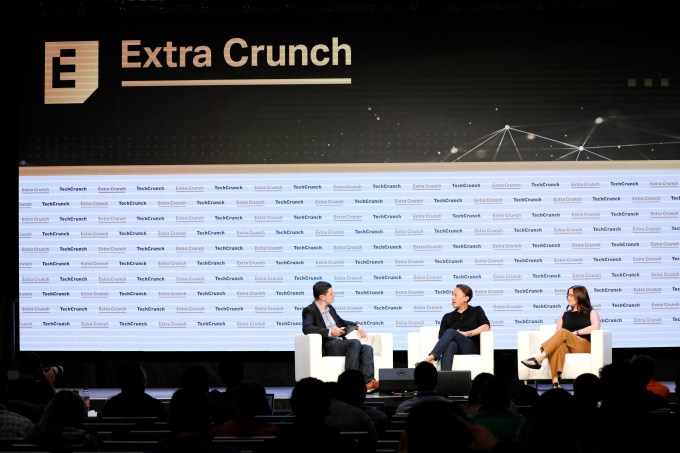
Danny Crichton, Mailchimp Co-founder - CEO Ben Chestnut and Kabbage Co-Founder - President Kathryn Petralia speak onstage during TechCrunch Disrupt San Francisco 2019 (Photo by Kimberly White/Getty Images for TechCrunch)
Second, we created a whole &Extra Crunch Stage& at our flagship conference Disrupt, again focused on solving the challenges that founders face every day. Among the panels we hosted were how to build a billion dollar subscription business, how to get into YC, how to build a startup culture, how to iterate a product, and how to exit your startup. What was great was the balance between our news-breaking Main Stage and the more skills-orinted EC stage. Plus, we also had a special members lounge for EC subscribers at the event, which proved even more popular that I would have predicted (yes, members want to feel exclusive!)
Finally, we also offer EC members a discount on our events, which has driven more attention to our Sessions events and to TechCrunch Disrupt Berlin, where we will have another EC stage this coming December. We love it when members show up in person, and so we wanted to incentivize that as much as we could could. Ita nice way to say thanks to our most enthusiastic customers.
Do: have a free newsletter for your paid content
This is one we accidentally stumbled upon but has worked really, really well. We have a free newsletter called the Extra Crunch Roundup (example issue) that summarizes the pieces we&ve published on EC.
Here is something crazy: we have about a 4:1 ratio of free users to paid users subscribing to the newsletter. In other words, roughly 80% of the users reading the subscription-focused newsletter don&t subscribe to Extra Crunch.
I can&t stress enough how useful this is. In some cases, these users don&t have access to EC because we haven&t launched in their country, or they haven&t made a purchase decision about us yet. By allowing them to stay tapped into our community, we keep them engaged and hopefully in the long run, turn them into customers.
Mistake: failing to fully integrate real-time analytics into editorial decision-making
Extra Crunch faces a typical business intelligence problem: our core user and analytics data is scattered across a number of data silos, and we don&t have a data lake (a term that, if used in an email sent to me, automatically sends the email to spam by the way). Like many smaller media companies, we lack the data science team and data pipeline engineers required to build out a full BI function.
I code, and I have been able to cobble together some Python scripts to pipeline some of our data into an Airtable so that we have at least decent visibility on what our readers like and what they don&t (in some cases involving manually scraping our own sites since some of our tools don&t have API access). But it doesn&t allow us to make real-time decisions about our content, and that acts as friction to delivering the best possible experience.
While analytics is obviously important for our business leaders, itreally editorial that needs the data the most. As I was building out the editorial strategy, I would have put even more time into thinking through our analytics strategy to ensure we had the right feedback mechanisms in place from day one to do quality data analysis.
Focused, steady progress against the media maelstrom
Itbeen exhilarating watching a product start on a whiteboard and now being enjoyed by paying customers.
Media, and particularly New York media, loves the ambitious editor that wants to shake things up and shoot for the stars with massive budgets and a huge vision. But the reality is that the gyrations in the media industry in Manhattan are entirely avoidable by focusing on users, getting the basics right, using feedback properly, and being sure to walk before you run.
TechCrunch has watched as new publications have jumped into covering the tech industry, old publications have withered and faded away, and every format of media has come and gone. What has ultimately worked for us is to stay true to our founding mission: to fairly cover the startup world and all of its facets. Thatwhy we&ve always been here, and if the data we have is any proof, a heck of a lot of people are willing to pay to ensure that focus continues for us. So to our early Extra Crunch members — thank you. And of course, the best is yet to come.
- Details
- Category: Technology
Read more: Product lessons from building our subscription service Extra Crunch
Write comment (100 Comments)Days out of Y Combinator, venture capitalists valued ZeroDown, a financial and real estate technology startup, at $150 million. The company had the perfect match of experienced founders and eye-popping ambitions to carve a new path to home ownership.
&I think we will be known as a company that makes it easier to buy a home in every single aspect,& ZeroDown co-founder and chief executive officer Abhijeet Dwivedi tells TechCrunch.
The startup, which has raised $30 million in total equity funding and more than $110 million in debt financing to help Bay Area residents make down payments on homes, now plans to take on Zillow and Redfin with its new home search engine.
The business, founded by former Zenefits chief operating officer Dwivedi, Laks Srini, Zenefits& former chief technology officer, and Hari Viswanathan, a former Zenefits staff engineer, was founded last year and quickly landed backing from Sam Altman, followed by consumer technology venture capital fund Goodwater Capital. Targeting those in the Bay Area, where costs of home ownership are amongst the highest in the country, ZeroDown charges $10,000 to purchase your home outright and front your entire down payment.
That is, however, if your home is priced between approximately $550,000 and $1,750,000 and you have an individual or combined salary of more than $200,000, stock options and some money put away (or some variation of this). If you meet these criteria, ZeroDown will purchase your home and lease it to you. The goal is to eliminate one of the largest pain points of home-buying, the down payment, and facilitate more real estate purchases.
The company says it intends to expand the service outside the greater San Francisco area to cities like Denver, Seattle and Austin, but given the $10,000 price tag and large population of wealthy tech workers in the Bay, the business could flourish in this area without expanding.
With the launch of its home search engine, Dwivedi says users will be able to learn about more than just the square footage of a home. The tool tells users whether a potential home is naturally lit, if it has a large backyard, if it has a decent commute to your work and to various schools and, most importantly, whether itdog friendly.
ZeroDown has also partnered with a number of San Francisco-based tech companies, including Pinterest, Postmates and Square, to provide their employees a rebate if they choose to purchase a home using ZeroDown.
&We know first-hand what companies need to support a great quality of life and keep their employees in the Bay Area,& Dwivedi said. &A part of that is loving where you live — feeling part of a local community.&
- Details
- Category: Technology
Read more: ZeroDown, valued at $150M, plans to take on Zillow
Write comment (99 Comments)NASA revealed new spacesuits, specifically created for the Artemis generation of missions, which aim to get the first American woman and the next American man to the surface of the Moon by 2024. The new designtoppling feature is greater mobility and flexibility, in basically every respect. NASA unveiled both a full suit designed for use in extra-vehicular activities on the surface of the Moon, and a flight suit for use while in transit to lunar orbit.
Guided by NASA Administrator Jim Bridenstine, the agency first demonstrated the suit that astronauts will use on the surface of the Moon (and, with modifications, eventually on Mars). Itcalled the ‘xEMU& variant, and it looks a lot like what you might think of when you imagine ‘space suit& in your mind. But itquite different in many respects from what astronauts used to visit the surface of the Moon during the Apollo program.
It allows you to actually moonwalk, for instance: The original suit used for Moon-based activities actually only offered enough range of motion for Neil Armstrong and Buzz Aldrin to be able to essentially &bunny hop& on the lunar surface, in Bridenstineown words. This new design allows them to move around much more dynamically, including actually walking, and offering plenty of range of motion for their arms. Combined with new gloves that actually even allow astronauts to freely move their fingers, they can do things like pick up rocks off the lunar surface with relative ease.
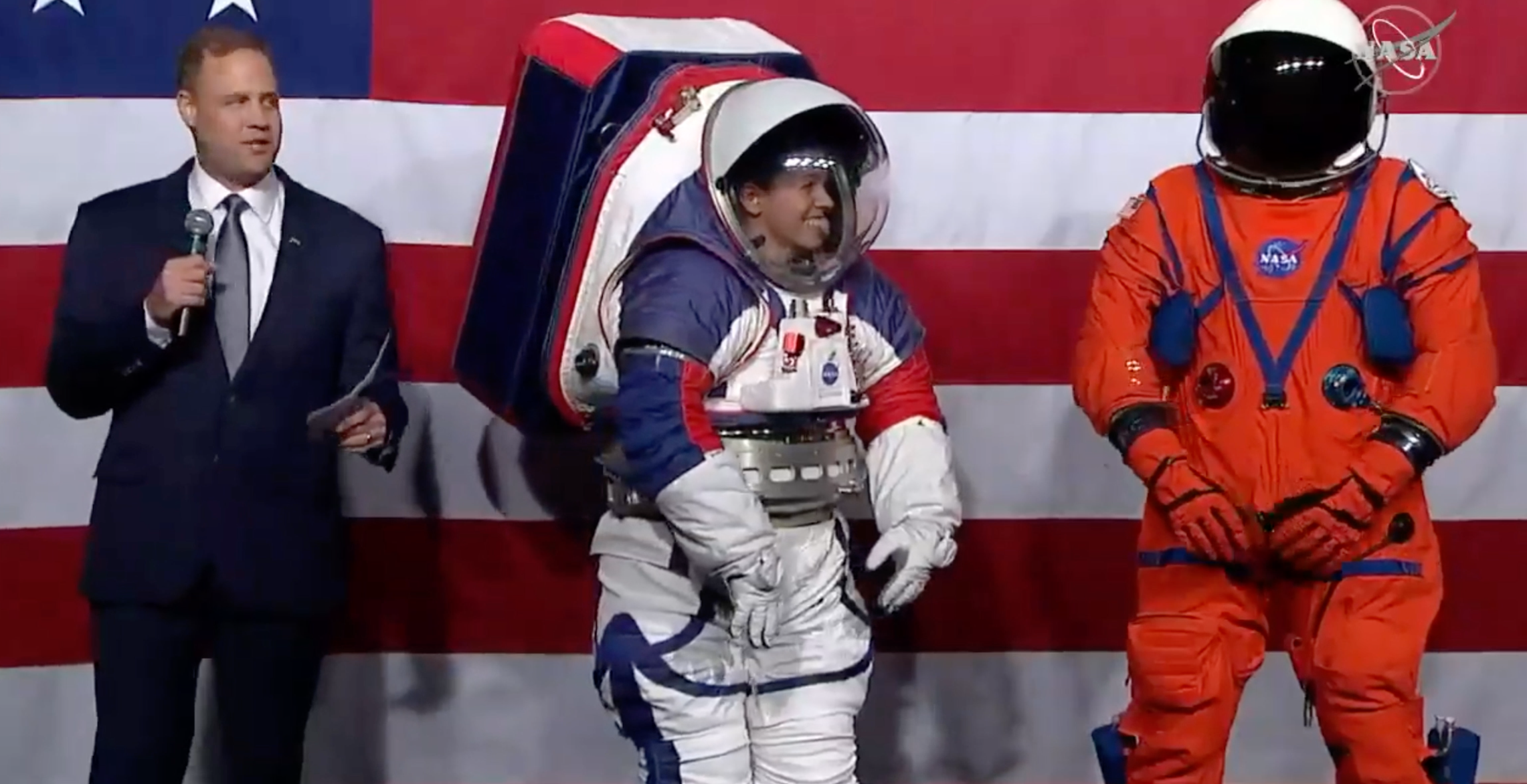
The new spacesuit design is also designed to work with virtually everyone who could want to become an astronaut, with inclusive sizing that can accommodate anyone from the &first percentile female to the 99th percentile male,& according to Kristine Davis, an Advanced Space Suit Engineer at NASA and the person who demonstrated the xEMU variant of the suit on stage at the event on Tuesday.
&We want every person who dreams of going into space to be able to say to themselves, that yes, they have that opportunity,& Bridenstine added regarding the suitinclusive design.
Because NASA is also looking to ensure that this time when they return to the Moon, they do so sustainably (meaning with the intent of eventually setting up shop and staying), they also designed this suit with a much higher range of temperature variances to ensure it can serve at both the North and South poles of the Moon, as well as around the equatorial region. This xEMU suit is designed to survive temperature ranges from between -250 and +250 degrees Fahrenheit.
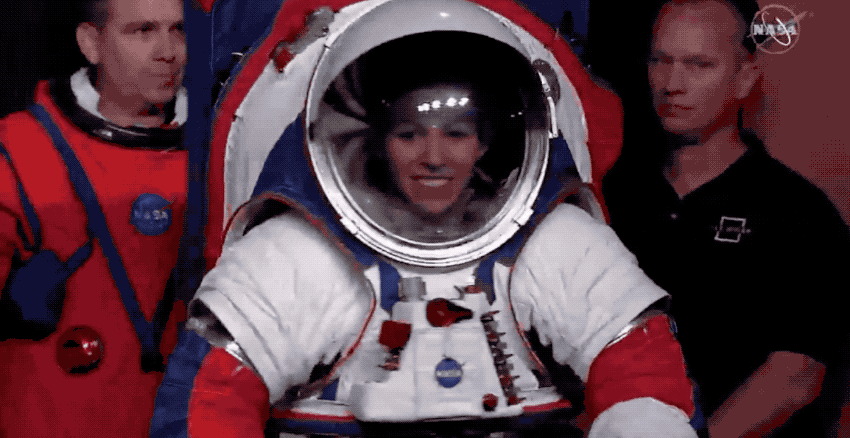 NASA also talked about how this is an improvement from the spacesuit currently used on the International Space Station. For one, this one has usable legs, where the legs on the ISS suits are essentially just for protection since you aren&t using them in zero and microgravity. The bearing designs used to connect the arms here also mean you have greater range of motion for reaching and grabbing, as mentioned.
NASA also talked about how this is an improvement from the spacesuit currently used on the International Space Station. For one, this one has usable legs, where the legs on the ISS suits are essentially just for protection since you aren&t using them in zero and microgravity. The bearing designs used to connect the arms here also mean you have greater range of motion for reaching and grabbing, as mentioned.
The other suit, called the &Orion Crew Survival Suit,& is a much lighter suit thatdesigned to be worn during take-off and landing. It&ll generally be depressurized when in use, but can provide protection in case of accidental depressurization. It was demonstrated by Dustin Gohmert, Project Manager on the Orion crew suit, who explained that it also has thermal protection and radiation protection, though not to the level of the xEMU.

The larger xEMU suit is also intentionally designed to be upgradeable, somewhat like a PC motherboard, and itdesigned so that it can be upgraded and worked on in space by the astronauts to adopt new and improved technologies as they become available, rather than having to be round-tripped back to Earth for updates.
Bridenstine re-iterated that NASA is also working with commercial partners on sourcing the production of the Artemis suits, as the agency announced earlier this month. Italso looking to these companies to provide advice and input about what to do in terms of future evolutions and upgrades for the technology used in the suit.
Overall, Bridenstine was obviously eager to talk about commercialization, and NASAeagerness to work with commercial partners on the Artemis program, and on space in general.
&What NASA has already done is invested in commercial resupply of the International Space Station […] We have invested now in commercial crew. And in the first part of next year, we&re going to once again launch American astronauts on American rockets from American soil for the first time since the retirement of the Space Shuttles in 2011,& he said. &Thatgoing to be a really positive development for our country, but itgoing to be commercial […] And of course, we want to see a lot of robust commercial habitats in low-Earth orbit as well. Ultimately, what that enables us to do is then take the resources that the taxpayers give us, and go to the Moon and on to Mars, always keeping an eye on commercialization even there. The goal here is to expand humanity further into space than ever before.&
- Details
- Category: Technology
Walmart will bring your groceries to you and put them away in the fridge, with the launch of its new service, InHome. The retailer is today debuting its new in-home grocery delivery service in three cities: Kansas City, (Missouri and Kansas); Pittsburgh, Pennsylvania; and Vero Beach, Florida. Customers in these markets can subscribe to InHome for $19.95 per month, then receive free, unlimited deliveries where Walmart associates enter their home and put the groceries away while live-streaming the delivery in real-time.
The retailer had previously detailed its plans to offer in-home grocery delivery earlier this year, saying that it would make it easier for customers to shop for groceries online.
Unlike with traditional e-commerce orders, groceries can&t sit outside on the doorstep for hours. Using insulated coolers to work around this problem can be costly, and it only buys a little more time. Instead, InHome delivery solves the problem of dealing with fresh and frozen groceries by simply putting them away at the time of delivery.
At launch, Walmart is partnering with Level Home for its front door smart entry technology andNortek Security - Control for its garage door smart entry technology. Level Home also today announced $71 million in funding, which included a strategic investment from Walmart.
From the InHome website, customers can select either device for $49.95 and receive free, professional installation. This is cheaper than if bought directly. When the lock goes on sale, it will retail for $250 next year when made available to the public.
Once customers begin their InHome subscription, they are able to try it free for to see if the service works for them. (The trial converts to a subscription if not canceled).
While deliveries won&t have other fees beyond the $19.95 per month InHome subscription, there is a $30 minimum order to use the service. In other words, itmeant to be used in place of a real grocery shopping trip, not just for a few items for dinner.
When ittime for delivery, the Walmart associate uses a one-time code to unlock the door or garage using the InHome app, which pairs with the supported smart entry device.
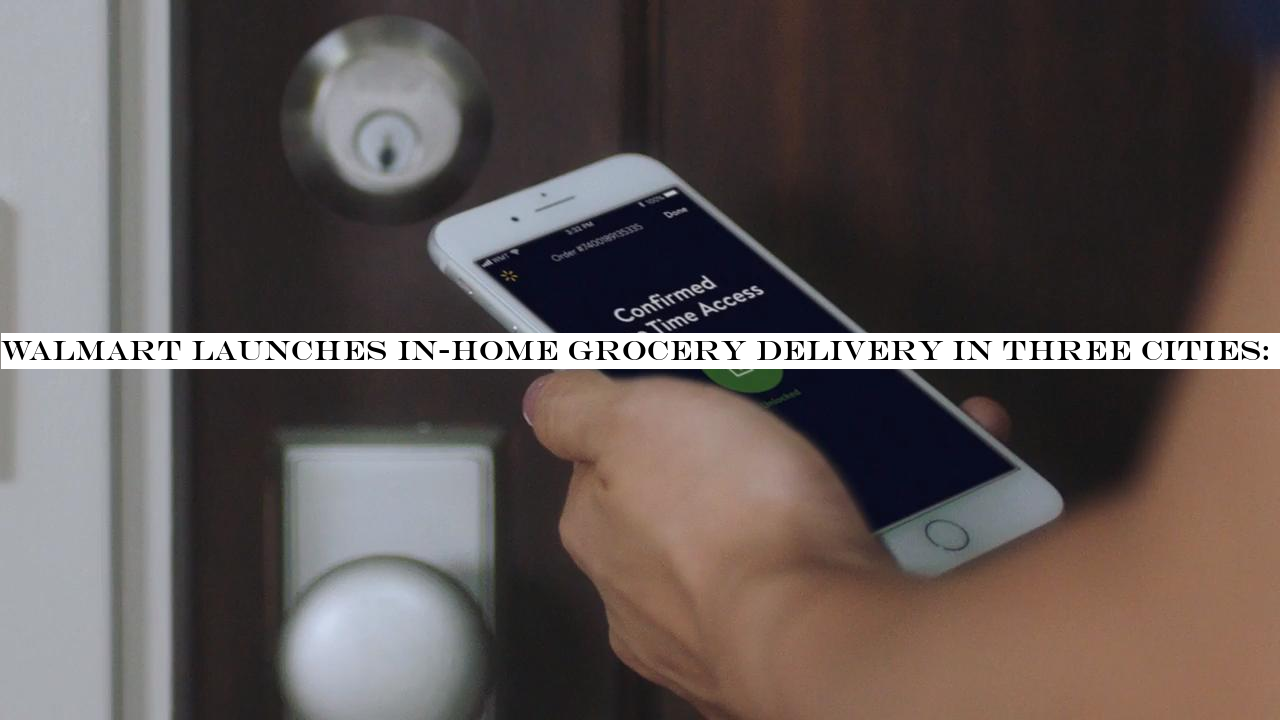
And to assuage customers& concerns about strangers entering their home when they&re not there to supervise, Walmart came up with the pretty wild idea to record the delivery in real-time so customers can watch it take place from afar.
On the associates& vest, they&ll wear a proprietary, live-streaming camera that sends video of the delivery right to the customerdevice. And if the camera doesn&t turn on, the door or garage door won&t unlock, Walmart says.
Walmart first rolled out InHome in a pilot in New Jersey for six months and has been running pilots in Kansas City and Pittsburgh for the last two months. It won&t say how many people have been using it, during these tests.
In the three markets live today, Walmart says InHome will be available across more than 20 total stores.
InHome is Walmartanswer to AmazonKey by Amazon service, which involves both in-home and in-car delivery of Amazon purchases. But unlike Key, which focuses on Amazon packages, InHome is for Walmart Grocery orders only, not Walmart.com merchandise.
The service is one of several ways Walmart has been expanding its online grocery business in recent months.

It also last month expanded its Delivery Unlimited service, an Instacart rival, across the U.S. At $12.95 per month, itthe better choice for anyone who was already getting delivery from Walmart Grocery at least twice per month, given the $9.99 per delivery fee.
And now, for a few dollars more, InHome, makes sense for those who want even less hassle when it comes to online grocery shopping.
Therean un-touted environmentally-friendly aspect to this service, as well. First, grocery delivery can end up being more efficient than everyone shopping for themselves, as drivers can often deliver a couple of orders on the same trip, when the customers are near each other. And the drivers could use larger cooler bags and other reusable containers, like crates, instead of plastic bags, for example, since they&re putting items away instead of handing them over. (Typically, grocery delivery services today bring your order in tons of plastic bags.)
Of course, individual stores may not enforce the use of reusable bags — that remains to be seen.
Walmart says the public launch of InHome will help it gain insights before it rolls out the service more broadly.
- Details
- Category: Technology
The Chromebook has been a marked hit for Google — well, for Googlehardware partners, at least. Low cost devices have flooded the market, with a stranglehold on the educational category in particular. Googleown first party offerings, on the other hand, have been a bit more curious.
Devices like the Pixelbook and Pixel Slate have pushed the $1,000 price point in an attempt to demonstrate Chrome OSviability in a more premium tier. With the Pixelbook Go, on the other however, Googleplaying much more to the cloud-based operating systemstrengths, with a far more accessible price point.
Starting at $649 (albeit configurable all the way up to ~$1,400), the Go is an attempt to play to Chrome OSbase: users looking for a more affordable entry point. After all, hasn&t that always kind of been the point of Chromebooks?

Of course, affordability comes with compromises. From a design perspective, that means losing some of the things that made the original Pixelbook so interesting. Top of the list are the convertible lid, which helps it double as a laptop and a tablet. Turns out 360-degree hinges are pretty cost prohibitive (though admittedly we&ve seen them on some fair cheap systems). And since the the hinge is gone, Google also opted to drop pen input, while retaining the touchscreen.
As with the original Pixelbook, there are still only two USB-C ports on-board (one one either side). That limits flexibility quite a bit. Of course, the company opted not to add more due, ion part, to pricing constraints. The company also tells me that most core Chromebook users should find two sufficient. Perhaps thatthe case with a majority of users.
Otherwise, the design is pretty nice, down to the colorful, ribbed bottom, which is designed to make the device easier to hold in one hand. Ditto for the lighter weight. Itan easier laptop to port around or toss in a bag on the go.

The keyboard has been improved, as well. Itquiet, as advertised (though admittedly I was using it in a fairly loud environment), and while the keys are on the soft side (especially compared to the MacBook, which is a bit like typing on chiclets), it has a pretty good feel to it. I could certainly see using this as my primary computer on that front, at least.
While Chrome OS has been vastly improved since its earliest days (thanks to, among other things, Android app compatibility), itstill limited for those looking to get more serious work done. The lower cost Go makes that gulf even more pronounced. On a personal note, I&ve run into issues try to do things like, say, audio editing on the product.
The lower price point also means that device starts from a lower power processor, with the m3 and 8GB of RAM You can bump it to 16GB and a Core i5 or i7, but that, naturally, will cost you. At a certain point you&re starting to get into original Pixelbook territory.

The original model is sticking around, by the way. No spec changes to speak of, however, in spite of the fact that ita two-year-old product. That one seems overdue for a bump, especially with another new model in the line.
It seems safe to assume that Googlegoing to move significantly more Gos than original Pixelbooks, based on price alone. Itan interesting slice of the market, targeted primarily at consumers looking for a cheaper entry point. The company isn&t really targeting the education market here, in spite of the Chromebooksuccess in the space. Google tells me that the product is simply priced too high for K-8 students.
[gallery ids="1897535,1897534,1897533,1897532,1897528,1897529,1897530,1897531"]
- Details
- Category: Technology
Read more: Up close with Google’s budget Chromebook, the Pixelbook Go
Write comment (98 Comments)Today, a new book called &Girls Who Run the World& hits real and virtual bookshelves, and for anyone with a middle-school aged kid or looking to inspire a high-schooler, it might be worth checking out. Featuring 31 women who are the CEOs of companies that they have created themselves — think Spanx, Glossier, Caribou Sciences, and Stitch Fix — each of their stories underscores that dreams sometimes can be made into reality when you want something badly enough.
We talked yesterday with the bookauthor, Diana Kapp, a longtime essayist (with an MBA from Stanford) who authored the book in part to encourage her own teenage daughter to pursue her passions while making clear there will be obstacles, always, to overcome.
TC: You have an interesting and fairly broad mix of powerful women in this book. How did you choose who to profile?
DK: I went after stories that are compelling and innovative, while trying to ensure that not every woman has a degree from either Stanford or MIT. I picked Anne Wojcicki because shea pioneer in the field of DNA testing. Nina Tandon of Epibone is working on growing artificial bones that can be put into the body. Christina Stembell of Farmgirl Flowers grew up on a farm and never went to college. Tracy Young was a construction project engineer who wound up selling her company to Autodesk. I could have written about 200 more women; there are so many good stories that are just not told.
TC: How much time did you spend with each of them?
DK: It really varied. I met some in person, like Tina Sharkey of Brandless and Christina (Stembell) and Kara Goldin of Hint Water. I interviewed a lot of them on the phone. I really wanted to tell the story of them taking an idea and having the guts to trust their own instincts and go after that idea, despite a lot of naysaying and difficulty fundraising. People thought Stitch Fix was an inventory nightmare, for example. At Minted, founder and CEO Mariam Naficy opened her online stationary store and not a single box sold for the first 40 days.
TC: Of the women you interviewed, who overcame the most?
DK: I love the story of Jesse Genet of Lumi, who became obsessed with screen printing in high school and would use every birthday to ask for some esoteric piece of printing equipment, finding out along the way about some light-activated agent that you could use for printing and driving six hours to get this product out of someonebasement. Today, her company provides packaging to a growing number of consumer companies, from Rockets of Awesome to Blue Bottle Coffee and I think shejust brilliant.
Jennifer Hyman and Jenny Fleiss bought 100 dresses in their own sizes in case [Rent the Runway] didn&t work. Katrina Lake similarly bought clothes on her credit card, then sent them to friends and used paper and pencil to mark down feedback before hiring a TaskRabbit to help track that data. Whatimportant about all of these stories is that these women took steps that others can take, too. They started with tiny pilot programs. They aren&t the kids of entrepreneurs. They weren&t preordained to start companies. And while I might read about them in Fast Company or listen to podcasts about them, my 14-year-old doesn&t. I think itimportant for kids to learn about people who would not take no for an answer, who got turned down by 40 VCs and kept pitching.
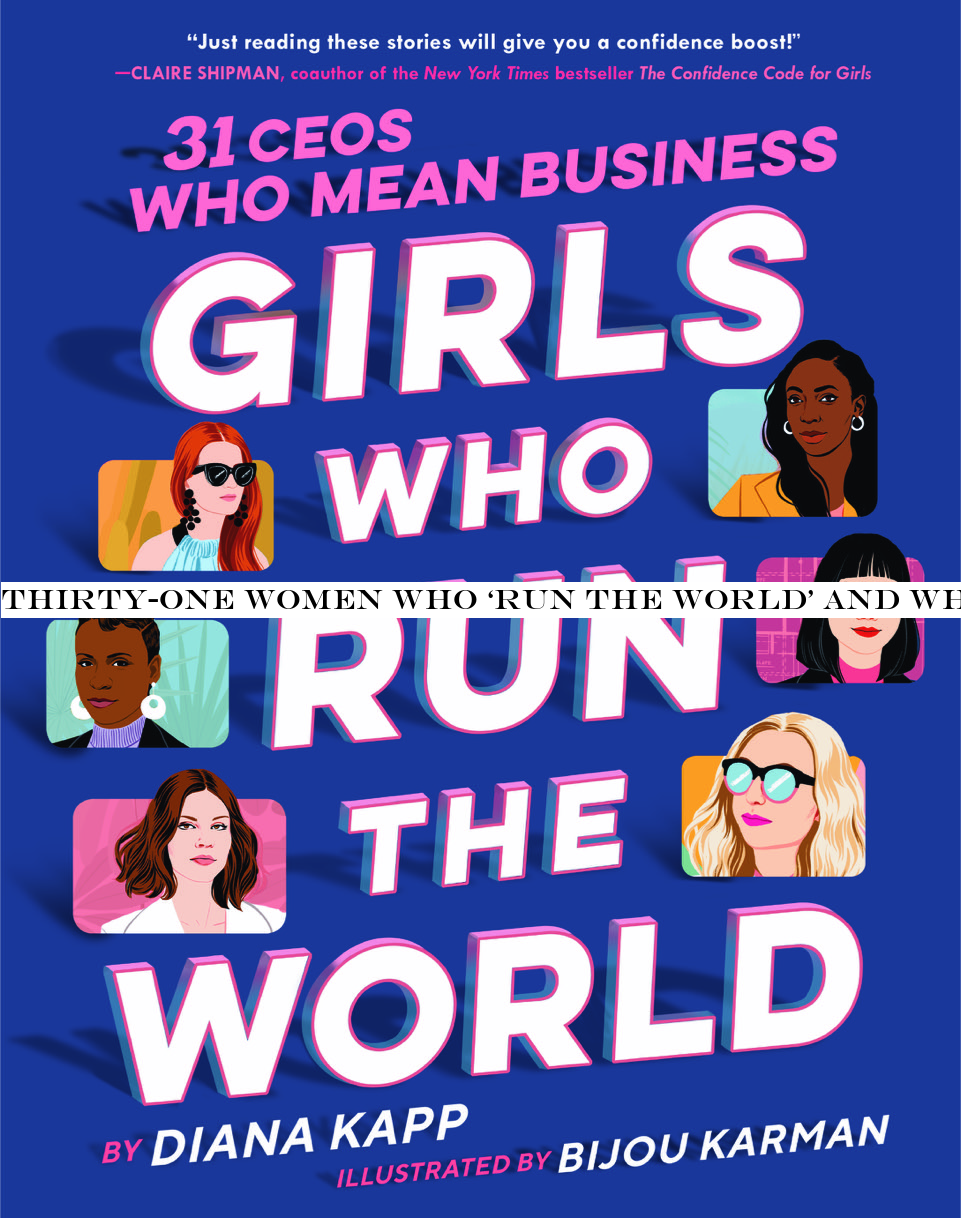
TC: You mentioned that you tried featuring women of different backgrounds. What were some of the unifying threads between them?
DK: One thing that does connect them is parents who ditched the idea of perfectionism. They let their girls take their own path. [PopSugar founder and president] Lisa Sugarparents let her stay up because she was obsessed with late-night TV, and thathow she got into being a pop culture critic and wound up launching a blog that had a million readers within a year. Sara Blakeley of Spanx told me her dad didn&t care what other people thought of him, which was a powerful idea for a kid to be marinating in; it gave her more freedom to be herself and to take her own path. Jesse [Genet] realized if she took two classes after the summer of her junior year in high school, she could graduate early and take her T-shirt printing business to L.A. where she had data on the number of shops per block, and when she pitched her parents on these ideas, they listened to her. They let her take a non-traditional path.
TC: Did any or many of these founders take time off to raise their children?
DK: I don&t know that they took time off, but 18 of the 31 have children, and 10 of them have three or four children, so they&re managing to have big families. Katia Beauchamp ran Birchbox while on bedrest with her fourth child. SoulCyclefounders brought their daughters to the studios they were opening up and had them pitch in. Kara Goldin, who was inspired to start her company after working in the software industry and gaining weight and drinking too much Diet Coke, really wanted to get [sales] going in Whole Foods before getting induced with her second child, so she brought bottles over to a local store [en route to the hospital]. When the stock guy called the next day to tell her all the cases were gone, she thought they&d been stolen.
I&m sure that like every parent, they feel the pull to spend time with their kids, but they are so turned on by what they are doing. You don&t [start a company] unless you have incredible passion for your idea because itso hard. And I love that they are having children but still chasing after something thatmeaningful to them and that they think society really needs. I think thata fantastic model for children.
TC: Were the people you&ve profiled been helped by other women along the way? Is that an important piece of their stories?
DK: There is a lot of support going on; they definitely have a network. Many sit on each otherboards or advisory committees. Katrina Lake is on Emily Weissboard [at Glossier]. Some of them sit on the board of [former model] Christie Turlingtonorganization, Every Mother Counts.
Leslie Blodgett, who sold her company Bare Escentuals to Shiseido [in 2010 for $1.7 billion] is funding other women. Shealso now a student at Stanford and writing a book. She wants to have another chapter.
- Details
- Category: Technology
Read more: Thirty-one women who ‘run the world’ and what can be learned from them
Write comment (98 Comments)Page 627 of 5614

 18
18





